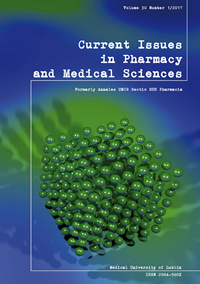Risks associated with betel quid chewing
DOI:
https://doi.org/10.1515/cipms-2017-0005Keywords:
betel, areca nut, oral cancer, esophagus cancer, cardiovascular disease, psychoactive substanceAbstract
Betel quid is one of the most commonly used psychoactive substances in the world, especially among Asian communities, just after caffeine, nicotine and alcohol. The mixture that is chewed usually contains betel leaves, areca nut and slaked lime, nonetheless, its ingredients and the preparation manner tend to vary. Areca nut contains four main alkaloids - arecoline, arecaidyne, guvacine and guvacoline that are responsible for its psychoactive effects. The act of betel chewing might have a negative impact on an overall health and can cause pathological lesions or diseases to develop and/or progress, both directly and indirectly. Also, it may happen that the negative impact of betel chewing on one system might have indirect harmful influence on another. Still an association has been drawn between betel chewing and the presence of metabolic diseases, cancers and proteinuria, as well as cardiovascular disorders - including hypertension, chronic renal failure, diabetics type II and obesity. Likewise, it is a known risk factor in the development of oral and esophagus cancer. Moreover, a correlation between betel chewing and smoking exists in that betel chewing might theoretically hinder the abandonment of tobacco smoking. Tissues of oral cavity and the upper part of digestive system are additionally exposed to the mechanical injuries caused by the areca nut. Therefore, they tend to be the most prone to be pathologically affected by betel quid chewing.
References
1. Al-Rmalli S.W., Jenkins R.O., Haris P.I.: Betel quid chewing elevates human exposure to arsenic, cadmium and lead. J. Hazard Mater., 190, 69, 2011. [Web of Science]
2. Al-Rmalli S.W., Jenkins R.O., Haris P.I.: Betel quid chewing as a source of manganese exposure: total daily intake of manganese in a Bangladeshi population. BMC Public Health., 11, 85, 2011. [Crossref] [Web of Science]
3. Boucher B.J., Mannan N.: Metabolic effects of the consumption of Areca catechu. Addict Biol., 7, 103, 2002. [Crossref]
4. Chang W.C. et al.: Betel nut chewing and other risk factors associated with obesity among Taiwanese male adults. Int. J. Obes. (Lond), 30, 359, 2006.
5. Chen F.L. et al.: The role of betel-quid chewing in smoking cessation among workers in Taiwan. BMC Public Health., 14, 755, 2014. [Web of Science] [Crossref]
6. Chu N.S.:Neurological aspects of areca and betel chewing. Addict Biol., 7, 111, 2002. [Crossref]
7. Gould A.J. et al.: Prospective cohort study of the relationship of markers of insulin resistance and secretion with weight gain and changes in regional adiposity. Int. J. Obes. Relat. Metab. Disord., 23, 1256, 1999.
8. Gupta P.C., Ray C.S.: Epidemiology of betel quid usage. Ann Acad Med Singap., 33, 31, 2004.
9. Gupta P.C., Warnakulasuriya S.: Global epidemiology of areca nut usage. Addict Biol., 7, 77, 2002. [Crossref]
10. Heck J.E. et al.: Betel quid chewing in rural Bangladesh: prevalence, predictors and relationship to blood pressure. Int J Epidemiol., 41, 462, 2012. [Web of Science]
11. Lin W.Y. et al.: Betel nut chewing is associated with increased risk of cardiovascular disease and all-cause mortality in Taiwanese men. Am J Clin Nutr., 87, 1204, 2008.
12. Lee B.K., Kim Y.: Relationship between blood manganese and blood pressure in the Korean general population according to KNHANES 2008. Environ Res., 111, 797, 2011. [Web of Science]
13. Liu W.H., Hsu C.C., Hsu Y.H.: Chewing areca nut as an independent risk factor for proteinuria in middle-aged men. Kaohsiung J Med Sci., 29, 214, 2013. [Crossref] [Web of Science]
14. Hsu Y.H. et al.: Association of betel nut chewing with chronic kidney disease: a retrospective 7-year study in Taiwan. Nephrology (Carlton), 16, 751, 2011. [Crossref] [Web of Science]
15. Johnston G.A., Krogsgaard-Larsen P., Stephanson A.: Betel nut constituents as inhibitors of gamma-aminobutyric acid uptake. Nature, 258, 627, 1975.
16. Mannan N., Boucher B.J., Evans S.J.: Increased waist size and weight in relation to consumption of Areca catechu (betel-nut); a risk factor for increased glycaemia in Asians in east London. Br J Nutr., 83, 267, 2000.
17. Parmar G. et al.: Effect of chewing a mixture of areca nut and tobacco on periodontal tissues and oral hygiene status. J Oral Sci., 50, 57, 2008.
18. Secretan B. et al.: WHO International Agency for Research on Cancer Monograph Working Group. A review of human carcinogens-Part E: tobacco, areca nut, alcohol, coal smoke, and salted fish. Lancet Oncol., 10, 1033, 2009. [Crossref]
19. Tung T.H. et al.: A population-based study of the association between areca nut chewing and type 2 diabetes mellitus in men (Keelung Community-based Integrated Screening programme No. 2) Diabetologia, 47, 1776, 2004.
20. Tseng C.H.: Betel nut chewing and incidence of newly diagnosed type 2 diabetes mellitus in Taiwan. BMC Res Notes, 3, 228, 2010.
21. Yamada T., Hara K., Kadowaki T.: Chewing Betel Quid and the Risk of Metabolic Disease, Cardiovascular Disease, and All-Cause Mortality: A Meta-Analysis. Bayer A, ed. PLoS ONE, 8, 2013.
22. Yen A.M.F. et al.: A population-based study of the association between betel-quid chewing and the metabolic syndrome in men. Am J Clin Nutr., 83, 1153, 2006.
23. Yen A.M.F. et al.: A prospective community-population-registry based cohort study of the association between betel-quid chewing and cardiovascular disease in men in Taiwan (KCIS no. 19). Am J Clin Nutr., 87, 70, 2008.
24. Zhang X., Reichart P.A.: A review of betel quid chewing, oral cancer and precancer in Mainland China. Oral Oncol., 43, 424, 2007.
Downloads
Published
Issue
Section
License
Copyright (c) 2017 Authors

This work is licensed under a Creative Commons Attribution-NonCommercial-NoDerivatives 3.0 Unported License.


